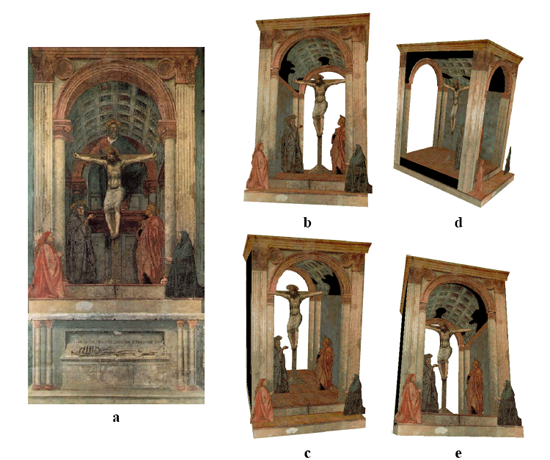|
3DVisA Resources
3DVisA Index of 3D Projects: Art History - Painting
Exploring the Paintings Third Dimension
Computer Techniques for the Analysis of Paintings
Part of research into the use of computer graphics and computer vision techniques in the history of art, the focus of this project was on analysing the geometry
of perspective in Renaissance paintings to learn about the perspectival skills of artists and explore the evolution of linear perspective in history. A 3D, XML-based,
interactive virtual museum has been proposed as a visualisation tool.

Fig. 1. Massacio (Tommaso di Ser Giovanni Guidi), The Trinity, c. 1426. Museo di Santa Maria Novella, Florence. The reprojection image is defined as the image created by projecting the computed three-dimensional reconstruction
onto the plane of the painting. © Musei Comunali di Firenze. Criminisi, Kemp and Zisserman. Reproduced with kind permission.
Algorithms for a systematic analysis of the two- and three-dimensional geometry of paintings were drawn from the work on 'single-view reconstruction'
and applied to interpreting works of art from the Italian Renaissance and later periods. Since a perspectival painting is not a photograph of an actual subject
but an artificial construction subject to imaginative manipulation and inadvertent inaccuracies, the internal consistency of its geometry must be assessed before
carrying out any geometric analysis. Some simple techniques to analyse the consistency and perspectival accuracy of the geometry of a painting were proposed, alongside
new algorithms for generating new views of a painted scene or portions of it, analysing shapes and proportions of objects, filling in occluded areas, performing a
complete three-dimensional reconstruction of a painting and a rigorous analysis of possible reconstruction ambiguities.
The validity of the techniques has been demonstrated on a number of historical paintings and frescoes, including The Flagellation by Piero della Francesca,
The Trinity by Masaccio and The Music Lesson by Johannes Vermeer. Whenever possible, the computer-generated results were compared to those obtained by
art historians through careful manual analysis.

Fig. 2. Three-dimensional reconstruction of Masaccio’s Trinity. (a) The original fresco in Santa Maria Novella,
Florence. (b-e) Different
views of the reconstructed three-dimensional model of the chapel depicted in the fresco. © Musei Comunali di Firenze. Criminisi, Kemp and Zisserman. Reproduced with kind permission.
Project dates: 2001(?)-2002
Resource status: ?
Contributors: Antonio Criminisi, Microsoft Research Ltd., Cambridge, UK; Martin Kemp, Department of the History of Art, University of Oxford, UK;
Andrew Zisserman, Department of Engineering Science, University of Oxford, UK.
Sources, images and further details:
Criminisi, A., Kemp, M. and Zisserman, A. (2003), 'Bringing Pictorial Space to Life: Computer Techniques for the Analysis of Paintings', Digital Art History, CHArt Yearbook,
I, London: Computers and the History of Art, pp. 77-99, Edited by A. Bentkowska, T. Cashen and H. Gardiner, A PDF version is available online.
Text by Antonio Criminisi. Record compiled by Anna Bentkowska-Kafel, 11 September 2006. Last updated:25 October 2007.
3DVisA gratefully acknowledges the help of Antonio Criminisi with preparation of this record.
© Criminisi, Kemp and Zisserman, and 3DVisA, 2006.
Back to the list of 3D projects
| 